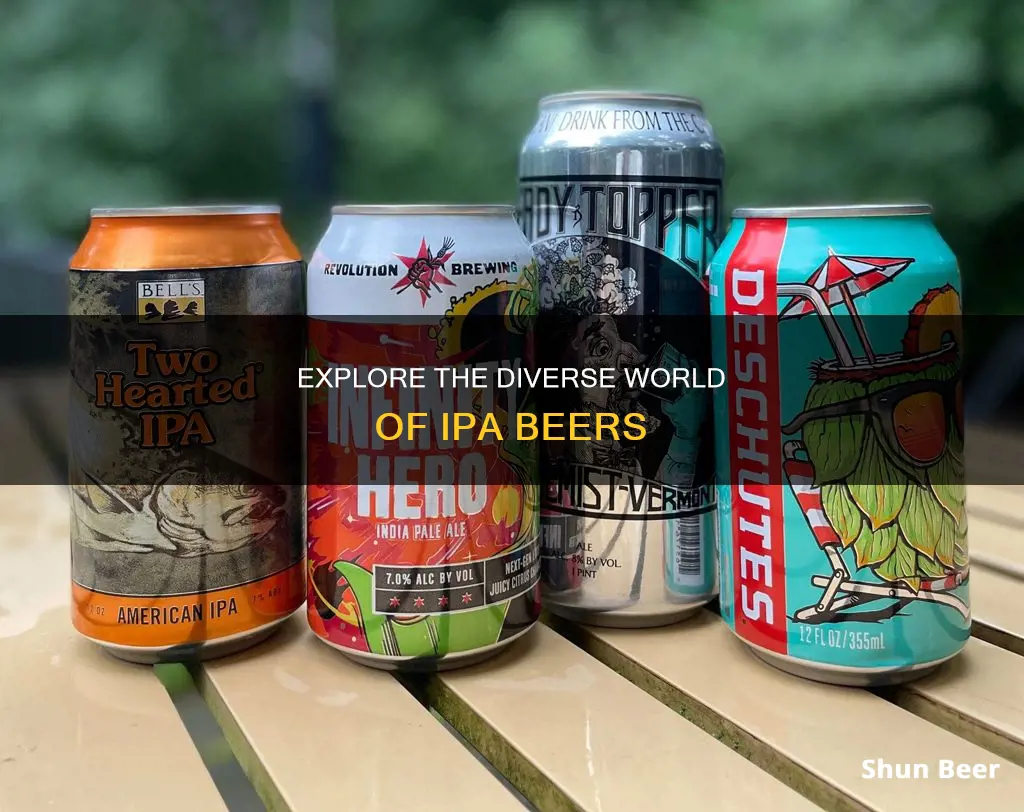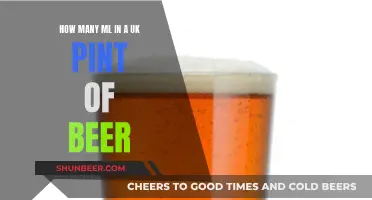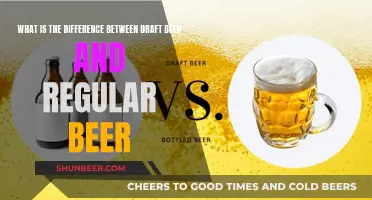
India Pale Ale, or IPA, is a beer style known for its hoppy bitterness. The term IPA encompasses innumerable versions, each slightly different from the last. While the original IPA was invented to survive the voyage from England to India in the 18th and 19th centuries, the style has since evolved and there are now many different types of IPAs on the market.
Characteristics of IPA Beers
| Characteristics | Values |
|---|---|
| Number of types | 9 |
| Original style | British IPAs |
| ABV | 4.5% - 13% |
| IBUs | 30 - 100 |
| Flavour notes | earthy, light citrus, stone fruit, banana, tropical fruit, grapefruit, pineapple, mango, pine, resin, floral, bitter, fruity, sweet |
| Appearance | cloudy, hazy, dark gold to brown, black |
| Texture | dry, pillow-like, creamy, effervescent |
| Brewing technique | dry-hopped, barrel-aged, kettle sour |
| Yeast | British, American, California, mutated, clean, flavourless, Belgian |
| Hops | Cascade, Citra, Chinook, Fuggles, Goldings, Mosaic, Galaxy, Amarillo, El Dorado, Centennial, Horizon, C-Hops |
| Malt | crystal malt, lactose |
What You'll Learn

West Coast IPA
The West Coast IPA originated in the 19th century when British trading companies in India started buying heavily-hopped ales from British breweries. These early IPAs were only slightly stronger in alcohol content than other popular British ales but were strongly hopped. Hops act as a preservative and stave off infection, allowing the beers to survive the naval passage from England. Demand for the style eventually grew back in England, and the IPA became a popular style of beer in the middle half of the 19th century.
In the 20th century, American craft brewers picked up the style, which blended well with hops grown in the Pacific Northwest, such as Cascade, Chinook, and Centennial hops. The West Coast IPA is thus heavily hopped, with a hop-forward flavour profile. It is traditionally bursting with dank resin notes and pine flavours and is considerably more bitter than its New England counterpart.
Some highly-rated examples of the style include:
- Firestone Walker Brewing Company Union Jack IPA
- Societe Brewing Company The Pupil
- Green Flash Brewing Co. West Coast IPA
- Russian River Brewing Co. Pliny the Elder
- Alpine Beer Company Duet
While the style has specific characteristics, there is room for variation. For example, in terms of hops, while classic West Coast hops include Centennial, Cascade, Mosaic, Amarillo, Chinook, Simcoe, and Strata, brewers might also use more contemporary hops like Citra.
Exploring Modelo's Diverse Beer Offerings: A Comprehensive Guide
You may want to see also

East Coast IPA
The East Coast IPA is a fairly new style of beer, originating in Vermont in the early 2000s. It is characterised by its strong hop flavour and aroma, high alcohol content, and fruity and floral notes. While the term "East Coast IPA" may be a misnomer, as the style is not exclusive to the East Coast of the United States, many popular examples do come from breweries in states such as Vermont, Massachusetts, and New York.
The flavour profile of an East Coast IPA is a balance of bitterness and sweetness, with notes of grapefruit, orange, and other citrus fruits. The bitterness is often less pronounced than in West Coast IPAs, with a focus on the hop flavour and aroma. The beer has a medium to full body, with a smooth and creamy mouthfeel, and moderate to low carbonation.
Popular examples of East Coast IPAs include the Julius IPA from Tree House Brewing Company, the Fort Point Pale Ale and Congress Street IPA from Trillium Brewing Company, and the Heady Topper IPA from The Alchemist.
A Wide Variety of Beers at Yard House
You may want to see also

Session IPA
Despite the lower alcohol content, session IPAs still pack a strong hoppy aroma and flavour. Brewers achieve this by using a wider variety of malts to add depth and complexity to the beer, ensuring that the hops do not overpower the malt flavours. The result is a beer that is lighter in body than traditional IPAs but still full-flavoured and highly drinkable.
Some popular examples of session IPAs include:
- Beavertown Neck Oil
- Lervig House Party
- The White Hag Little Fawn
- Boulevard Brewing Co. Pop-Up Session IPA
- Heavy Seas Beer Cross Bones
- Speakeasy Ales & Lagers Baby Daddy Session IPA
- Samuel Adams / Boston Beer Company Rebel Rider IPA
- Stone Brewing Company Go To IPA
- Lagunitas Daytime
- Firestone Walker Brewing Company Easy Jack
Mixing Beers: Is It a Sin or a Win?
You may want to see also

Black IPA
The style was created by influential brewer Greg Noonan in the 80s and 90s, who brewed Blackwatch IPA in 1990, a beer ahead of its time. The term "Cascadian Dark Ale" was coined by homebrewer Bill Wood in 2007. Black IPAs gained popularity in the early 2010s, especially on the West Coast of America, where hops are grown. Many large breweries commercially produced black IPAs during this time, and the style remained in demand for about five years.
Some examples of Black IPAs include:
- Wookey Jack by Firestone Walker Brewing Co.
- Sublimely Self-Righteous by Stone Brewing
- Raven by Tree House Brewing Company
- Black Hearted Ale by Bell’s Brewery
Exploring the Diverse Michelob Ultra Beer Family
You may want to see also

New England IPA
The New England IPA is characterised by its trademark opaque haze appearance, dense creamy head, and orange or golden yellow body. The haze is generated by specific new-world origin oats and wheat, suspended hop oils, and occasionally the addition of wildflowers.
The aroma and flavour profile of a New England IPA is fruity or tropical, with notes of passionfruit, guava, papaya, mango, and pineapple. The bitterness is often secondary, with a more moderate bitterness than other IPAs.
The New England IPA is a relatively new style, originally brewed in Vermont, a small state in the New England region of the United States. It gained popularity around 2011 and is now considered one of the most common IPAs, often referred to as a "hazy IPA". The haze in these beers is caused by a combination of brewing techniques, including the use of specific yeast strains, the timing of hop additions, and water chemistry adjustments.
Explore Beer's Diverse World: Styles and Classifications Unveiled
You may want to see also
Frequently asked questions
There are several types of IPAs, including the New England or East Coast IPA, the West Coast IPA, the Session IPA, the Double or Imperial IPA, the Triple IPA, the Black IPA, the White IPA, the Brut IPA, the Sour IPA, and the Milkshake or Lactose IPA.
IPA stands for India Pale Ale. IPAs are characterised by their use of hops, which were originally used as a preservative during the beer's voyage from England to India.
Also known as a hazy IPA, this style of IPA is known for its tropical notes and sweeter flavours, such as pineapple and mango. It is considered the least challenging and most approachable style of IPA.
This style of IPA is more bitter with a low caramel character and a sharper, more assertive flavour. It has a more piney, resin-like flavour and is best suited for those who already have some exposure to IPAs.
Session IPAs are lighter in body compared to traditional IPAs, but still pack a strong hoppy aroma. They are designed for casual drinkers who want to enjoy multiple beers in one sitting, with an ABV that never goes above 5%.







